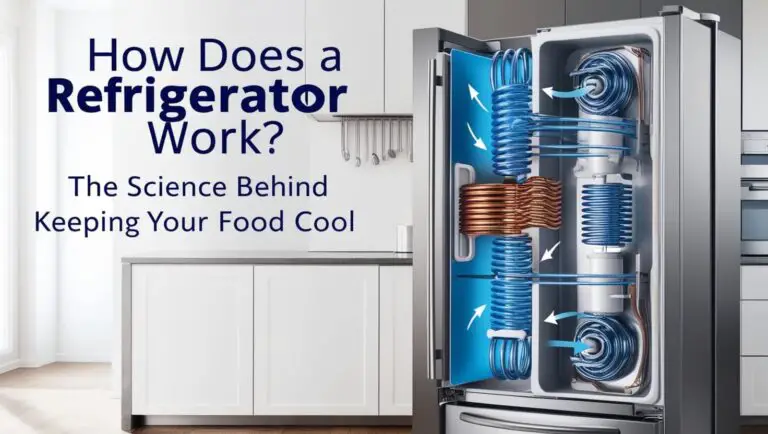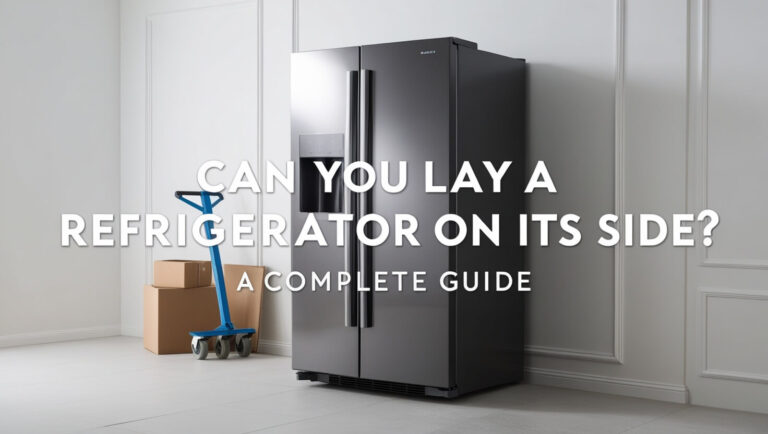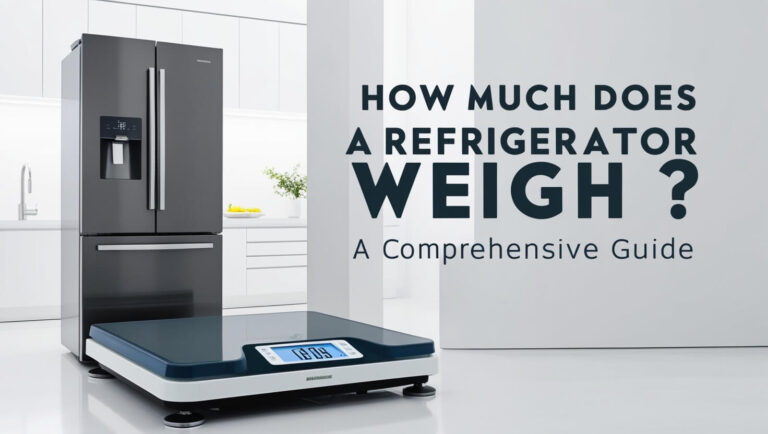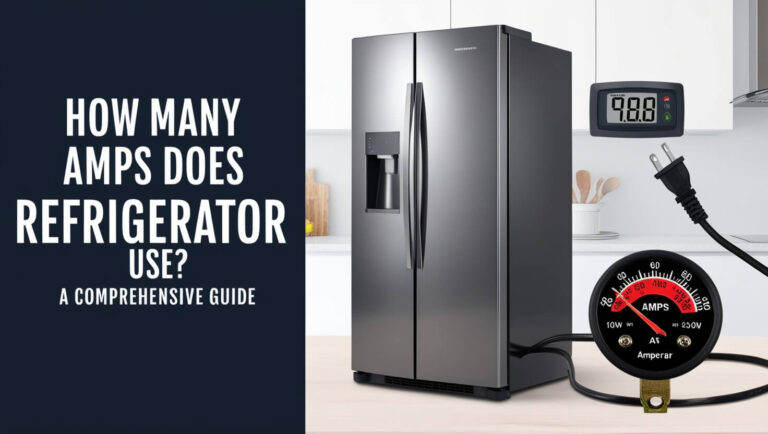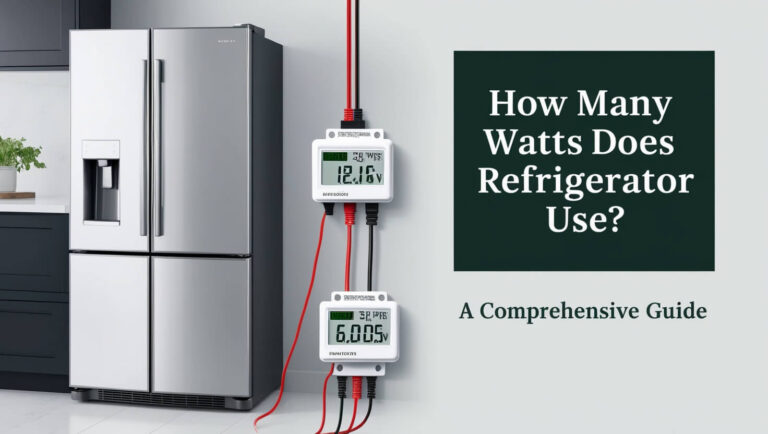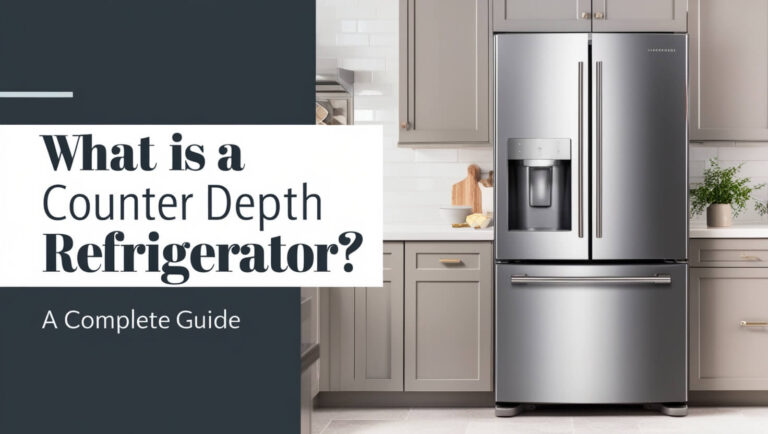What Temperature Should a Refrigerator Be? A Complete Guide
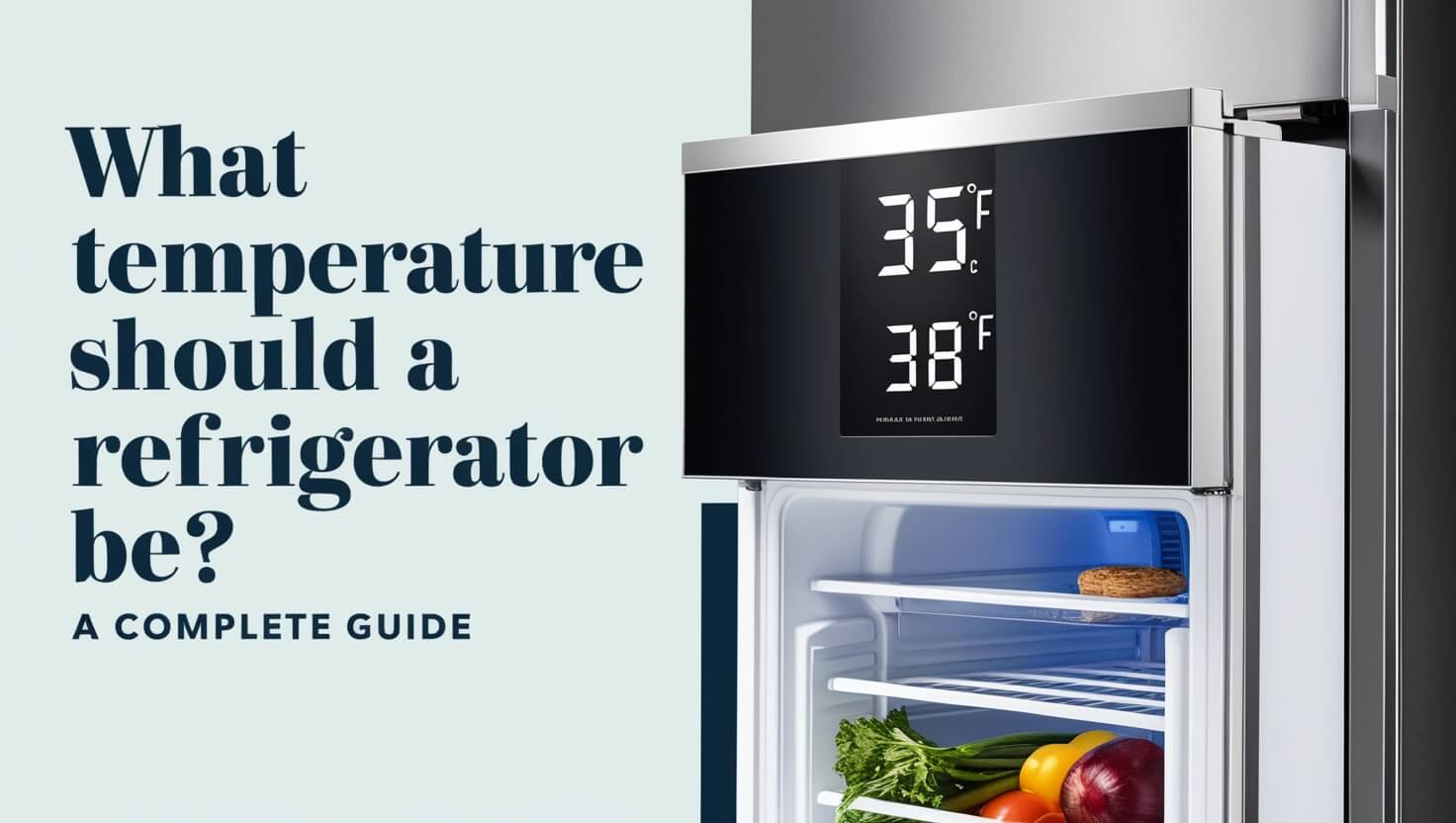
Ever wondered about the perfect temperature for your refrigerator? You’re not alone. Setting the right temperature is crucial for keeping your food fresh and safe to eat. In this comprehensive guide, we’ll explore everything you need to know about refrigerator temperature, from the ideal setting to troubleshooting common issues.
The optimal refrigerator temperature is between 35°F and 38°F (1.7°C to 3.3°C). This range keeps food fresh while preventing bacterial growth. For your freezer, aim for 0°F (-18°C) or below. These temperatures ensure food safety and help maintain the quality of your groceries.
Let’s dive deeper into the world of refrigerator temperatures and learn how to keep your food at its best.
The Ideal Refrigerator Temperature
Getting your fridge temperature right is essential for food safety and quality. Let’s break down the perfect temperature range and why it matters.
Recommended Temperature Range
The sweet spot for your refrigerator temperature is between 35°F and 38°F (1.7°C to 3.3°C). This range is cool enough to slow bacterial growth but not so cold that it freezes your food.
Why this specific range? Here’s the scoop:
- Above 40°F (4.4°C): Bacteria grow rapidly, increasing the risk of foodborne illness
- Below 32°F (0°C): Food starts to freeze, affecting texture and quality
Keeping your fridge in the 35°F to 38°F range strikes the perfect balance.
Why This Range Matters for Food Safety
Food safety is the top reason for maintaining the right refrigerator temperature. Here’s why:
- Slows bacterial growth: Cold temperatures slow down the reproduction of bacteria, keeping your food safer for longer.
- Preserves nutrients: The right temperature helps maintain the nutritional value of your food.
- Prevents spoilage: Proper cooling extends the shelf life of perishables.
Remember, your refrigerator is your first line of defense against foodborne illnesses. Getting the temperature right is crucial.
Factors Affecting Refrigerator Temperature
Several factors can impact your fridge’s temperature:
- Room temperature: Higher ambient temperatures make your fridge work harder.
- Frequency of door openings: Every time you open the door, warm air enters.
- Amount of food stored: A full fridge maintains temperature better than an empty one.
- Ventilation: Proper airflow around the fridge helps it operate efficiently.
Keep these factors in mind when setting and maintaining your refrigerator temperature.
Understanding Your Refrigerator’s Cooling System
To maintain the right temperature, it helps to understand how your fridge works. Let’s take a quick look under the hood.
How Refrigerators Work
Refrigerators use a simple but clever process to keep your food cool:
- Compression: A compressor pressurizes refrigerant gas.
- Condensation: The hot, pressurized gas cools and turns to liquid.
- Expansion: The liquid refrigerant expands, absorbing heat from inside the fridge.
- Evaporation: The refrigerant turns back into a gas, completing the cycle.
This continuous cycle removes heat from inside the fridge, keeping your food cool.
Different Types of Cooling Systems
Not all refrigerators cool the same way. Here are the main types:
- Single evaporator systems: One cooling unit for both fridge and freezer.
- Dual evaporator systems: Separate cooling for fridge and freezer compartments.
- French door models: Often use multiple air flows for more even cooling.
Understanding your fridge’s cooling system can help you troubleshoot temperature issues more effectively.
Impact on Temperature Consistency
The type of cooling system affects how consistent the temperature stays in your fridge:
- Single evaporator systems may have more temperature fluctuations.
- Dual evaporator systems often maintain more stable temperatures in each compartment.
- Multiple air flow systems can provide more even cooling throughout the fridge.
Keep your cooling system in mind when checking and adjusting your refrigerator temperature.
Setting and Adjusting Your Refrigerator Temperature
Now that we understand the ideal temperature and how fridges work, let’s look at how to set and adjust your refrigerator temperature.
Locating the Temperature Controls
Temperature controls can vary by model:
- Dial controls: Often found inside the fridge, usually numbered 1-5 or 1-7.
- Digital controls: May be on the front of the fridge or inside.
- Smart fridges: Might have app-controlled temperature settings.
Check your refrigerator’s manual if you’re having trouble finding the controls.
Steps to Adjust the Temperature
Here’s a general guide to adjusting your fridge temperature:
- Check the current temperature with a fridge thermometer.
- Adjust the control slightly (1 number or degree at a time).
- Wait 24 hours for the temperature to stabilize.
- Check the temperature again and adjust if needed.
Remember, patience is key. Give your fridge time to adjust before making further changes.
Common Mistakes When Setting Refrigerator Temperature
Avoid these common pitfalls when setting your fridge temperature:
- Setting it too cold: This wastes energy and may freeze some foods.
- Making big adjustments: Small, gradual changes work best.
- Ignoring seasonal changes: You may need different settings in summer and winter.
- Forgetting to check: Regular temperature checks help catch issues early.
By avoiding these mistakes, you’ll keep your fridge running efficiently and your food at its best.
Measuring Refrigerator Temperature Accurately
Knowing how to measure your fridge’s temperature accurately is crucial for maintaining the right environment for your food.
Types of Refrigerator Thermometers
Several types of thermometers can help you monitor your fridge temperature:
- Standard fridge thermometers: Inexpensive and easy to read.
- Digital thermometers: Often more accurate and easier to read.
- Wireless thermometers: Allow you to check the temperature without opening the door.
Choose a thermometer that’s easy for you to use and read regularly.
Where to Place Thermometers for Best Results
Placement matters when measuring fridge temperature:
- Center shelf: This gives you the average temperature of the main compartment.
- Door: The warmest part of the fridge, good to know for storing less perishable items.
- Back of a shelf: The coldest area, important for highly perishable foods.
Consider using multiple thermometers to get a complete picture of your fridge’s temperature zones.
How Often to Check Refrigerator Temperature
Regular temperature checks help ensure your fridge is performing optimally:
- Check at least once a week.
- Check more frequently during hot weather.
- Always check after power outages or appliance issues.
Consistent monitoring helps you catch and address temperature fluctuations quickly.
Temperature Zones Within Your Refrigerator
Your fridge isn’t uniformly cold. Understanding the temperature zones can help you store food more effectively.
Coldest Areas in Your Fridge
The coldest spots in most refrigerators are:
- The back of the bottom shelf
- The meat drawer (if your fridge has one)
- The back of other shelves
Use these areas for highly perishable items like raw meat, fish, and dairy products.
Warmer Spots to Be Aware Of
Some areas of your fridge tend to be warmer:
- The door shelves
- The top shelf
- The crisper drawers (designed to be slightly warmer and more humid)
Store less perishable items like condiments, butter, and produce in these areas.
Organizing Food Based on Temperature Zones
Optimize your food storage by placing items in the right temperature zones:
- Bottom shelf (coldest): Raw meat, fish, poultry
- Middle shelves: Dairy, eggs, deli meats
- Top shelf: Leftovers, ready-to-eat foods
- Door: Condiments, juices
- Crisper drawers: Fruits and vegetables
Proper organization helps maintain food quality and safety.
Optimal Freezer Temperature
While we’re focusing on refrigerator temperature, it’s important to understand freezer temperature too, as they’re often part of the same appliance.
Recommended Freezer Temperature
The ideal freezer temperature is 0°F (-18°C) or below. This temperature:
- Stops bacterial growth
- Preserves food quality
- Prevents freezer burn
Keep your freezer at or below this temperature for best results.
Relationship Between Fridge and Freezer Temperatures
In many refrigerators, the fridge and freezer temperatures are linked:
- Adjusting the freezer may affect fridge temperature
- Some models use the freezer to cool the fridge compartment
Understanding this relationship can help you troubleshoot temperature issues.
Signs Your Freezer Temperature Is Off
Watch for these signs that your freezer might not be cold enough:
- Ice cream is soft
- Frost or ice crystals on food packages
- Meat thaws quickly when moved to the fridge
If you notice these signs, check and adjust your freezer temperature promptly.
Impact of External Factors on Refrigerator Temperature
Your fridge doesn’t operate in isolation. External factors can affect its performance and temperature.
Room Temperature and Humidity
The environment around your fridge matters:
- Higher room temperatures make your fridge work harder
- High humidity can lead to more frost buildup
- Extreme temperature changes can affect fridge performance
Try to keep your kitchen at a consistent, moderate temperature for best results.
Refrigerator Location in Your Kitchen
Where you place your fridge can impact its efficiency:
- Avoid direct sunlight
- Keep away from heat sources like ovens and radiators
- Ensure proper ventilation around the fridge
The right location helps your fridge maintain the correct temperature more easily.
Frequency of Door Openings
Every time you open the fridge door, you let warm air in:
- Limit how often you open the door
- Know what you want before opening
- Close the door quickly
Reducing door openings helps maintain a consistent temperature inside your fridge.
Maintaining Consistent Refrigerator Temperature
Keeping your fridge temperature steady requires some regular maintenance and good habits.
Regular Cleaning and Maintenance Tips
A clean, well-maintained fridge runs more efficiently:
- Clean spills immediately to prevent odors and bacteria growth
- Vacuum refrigerator coils every 6 months
- Check and clean door seals regularly
- Defrost manual-defrost freezers when frost is 1/4 inch thick
Regular maintenance helps your fridge keep its cool.
Proper Food Storage Practices
How you store food affects fridge temperature:
- Don’t overcrowd shelves; allow air to circulate
- Let hot foods cool before refrigerating
- Use airtight containers to prevent moisture loss
- Organize items for quick retrieval to minimize door-open time
Good storage habits help maintain temperature and food quality.
Dealing with Power Outages
Power outages can threaten food safety. Here’s what to do:
- Keep the door closed as much as possible
- A full freezer can maintain temperature for up to 48 hours if unopened
- Use a thermometer to check temperatures when power returns
- Discard perishables if temperature exceeds 40°F for more than 2 hours
Being prepared helps you handle power outages effectively.
Common Refrigerator Temperature Problems and Solutions
Even with proper care, you might encounter temperature issues. Here’s how to tackle common problems.
Fridge Running Too Warm
If your fridge isn’t cold enough:
- Check the thermostat setting
- Ensure vents aren’t blocked by food
- Clean the condenser coils
- Check the door seal for leaks
If these steps don’t help, you may need professional service.
Fridge Running Too Cold
If your fridge is freezing food:
- Adjust the thermostat to a warmer setting
- Move sensitive items away from cold air vents
- Check if the temperature control is working correctly
Persistent issues might indicate a faulty thermostat.
Inconsistent Temperatures Across the Refrigerator
If some areas are too warm or cold:
- Ensure proper air circulation by not overcrowding
- Check for blocked vents
- Use a thermometer to map temperature zones
- Consider a fridge with dual cooling systems for better consistency
Understanding your fridge’s cooling patterns helps you use it more effectively.
Energy Efficiency and Refrigerator Temperature
The right temperature isn’t just about food safety—it also affects your energy bills.
Balancing Temperature and Energy Consumption
Finding the sweet spot:
- Setting the temperature too low wastes energy
- Setting it too high risks food safety
- The recommended 35°F to 38°F range balances safety and efficiency
Small adjustments can make a big difference in energy use.
Energy-Saving Tips for Your Refrigerator
Try these tips to reduce your fridge’s energy consumption:
- Keep the fridge full (use water bottles if needed)
- Cover liquids to reduce moisture in the air
- Let hot foods cool before refrigerating
- Check and replace door seals as needed
These habits can help lower your energy bills while maintaining the right temperature.
When to Consider Upgrading Your Refrigerator
An old or inefficient fridge might be costing you:
- Consider upgrading if your fridge is over 10 years old
- Look for ENERGY STAR certified models
- New features like dual cooling systems can improve efficiency
A new, efficient fridge can save money in the long run.
Food Safety and Refrigerator Temperature
Proper refrigerator temperature is crucial for food safety. Let’s explore why.
Danger Zone for Bacterial Growth
The “Danger Zone” is between 40°F and 140°F (4°C to 60°C):
- Bacteria multiply rapidly in this temperature range
- Food shouldn’t be in the Danger Zone for more than 2 hours
- Keeping your fridge below 40°F prevents entering the Danger Zone
Understanding the Danger Zone helps you appreciate the importance of proper fridge temperature.
How Proper Temperature Prevents Foodborne Illness
The right fridge temperature protects your health by:
- Slowing bacterial growth
- Maintaining food quality and nutrients
- Extending the safe storage time of perishables
Consistent, proper temperature is your best defense against foodborne illnesses.
Safe Storage Times for Common Foods
Even at the right temperature, food doesn’t last forever. Here are some guidelines:
- Raw poultry and ground meats: 1-2 days
- Raw beef, pork, lamb: 3-5 days
- Lunch meats: 3-5 days after opening
- Eggs: 3-5 weeks
- Leftovers: 3-4 days
Always check for signs of spoilage before consuming refrigerated foods.
Special Considerations for Different Types of Refrigerators
Not all fridges are created equal. Let’s look at some special considerations for different types.
Side-by-Side Models
Side-by-side refrigerators have unique features:
- Separate temperature controls for fridge and freezer
- Narrower shelves might affect food placement
- Door storage often less cold than interior shelves
Adjust your storage habits to suit the side-by-side layout.
French Door Refrigerators
French door models offer:
- Wide shelves for large items
- Often feature separate cooling systems for fridge and freezer
- Bottom freezer drawer can be more energy-efficient
Take advantage of the layout to organize your food effectively.
Mini Fridges and Wine Coolers
Smaller units have special considerations:
- Mini fridges may have less consistent temperatures
- Wine coolers are designed for higher temperatures than food fridges
- Both may be more affected by room temperature
Monitor these units more closely and adjust settings as needed.
Smart Refrigerators and Temperature Control
Technology is changing how we manage our fridges. Let’s explore smart fridge features.
Features of Smart Refrigerators
Smart fridges offer advanced temperature control:
- Wi-Fi connectivity for remote monitoring
- Touchscreen displays for easy adjustment
- Multiple temperature zones for different food types
These features can help maintain optimal temperatures more easily.
Apps and Notifications for Temperature Monitoring
Smart fridge apps provide:
- Real-time temperature monitoring
- Alerts for temperature fluctuations
- Reminders for maintenance tasks
These tools help you stay on top of your fridge’s performance.
Pros and Cons of Smart Temperature Control
Consider these points when deciding on a smart fridge:
Pros:
- Precise temperature control
- Easy monitoring and adjustment
- Potential energy savings
Cons:
- Higher initial cost
- Potential for technical issues
- Privacy concerns with connected appliances
Weigh these factors against your needs and preferences.
Seasonal Adjustments to Refrigerator Temperature
Summer considerations During the hot summer months, your refrigerator has to work harder to maintain its cool interior. To help it perform efficiently:
- Adjust the temperature setting slightly lower to compensate for the warmer ambient temperature.
- Avoid opening the door frequently, as this allows warm air to enter.
- Let hot foods cool down before placing them in the refrigerator.
- Ensure proper ventilation around the appliance to prevent overheating.
Winter adjustments In colder months, your refrigerator may not need to work as hard:
- You might be able to adjust the temperature setting slightly higher.
- Be cautious of extremely cold garage or basement temperatures, which can cause the compressor to run less frequently, potentially allowing food to spoil.
- Monitor the freezer section, as it may become too warm if the ambient temperature drops significantly.
Humidity and its impact on refrigerator performance Humidity levels can affect your refrigerator’s efficiency:
- High humidity can cause excess condensation inside the fridge, leading to frost buildup.
- Use the humidity controls on crisper drawers to maintain optimal conditions for fruits and vegetables.
- In humid climates, consider using a dehumidifier in the room where your refrigerator is located.
Conclusion
- Recap of key points
- Proper refrigerator temperature is crucial for food safety and energy efficiency.
- The ideal temperature range for a refrigerator is between 35°F (1.7°C) and 38°F (3.3°C).
- Regular maintenance, including cleaning coils and checking door seals, is essential.
- Different foods require different storage conditions within the refrigerator.
- Modern features like smart sensors and multi-zone cooling can enhance temperature control.
- Seasonal adjustments may be necessary to maintain optimal performance.
- Importance of maintaining proper refrigerator temperature Maintaining the correct temperature in your refrigerator is not just about keeping your food cold; it’s a critical factor in ensuring food safety, preserving food quality, and maximizing energy efficiency. By understanding the principles of refrigerator temperature control and implementing the tips and strategies discussed in this article, you can:
- Prevent foodborne illnesses by inhibiting bacterial growth.
- Extend the shelf life of your groceries, reducing food waste and saving money.
- Preserve the nutritional value and taste of your food.
- Optimize your refrigerator’s energy consumption, potentially lowering your electricity bills.
- Prolong the life of your appliance through proper usage and maintenance.
Remember, your refrigerator is one of the hardest-working appliances in your home. By giving it the attention it deserves and maintaining proper temperature control, you’re not just taking care of an appliance – you’re safeguarding your family’s health and contributing to a more sustainable lifestyle. Regular monitoring, timely adjustments, and a good understanding of your refrigerator’s features will ensure that it continues to serve you efficiently for years to come.

